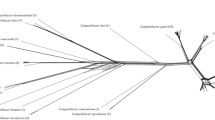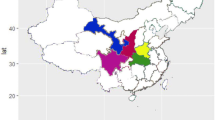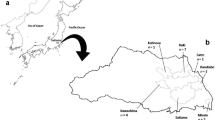Abstract
Main conclusion
Presenting a basic framework for using MLST to characterize Spirodela, Landoltia and in particular Lemna strains at the species level, and to study population genetics and evolution history of natural duckweed populations.
Abstract
Duckweed is widely used in environmental biotechnology and has recently emerged as a potential feedstock for biofuels due to its high growth rate and starch content. The genetic diversity and composition of a natural duckweed population in genera Spirodela, Landoltia and Lemna from Lake Tai, China, were investigated using probabilistic analysis of multilocus sequence typing (MLST). The 78 strains were categorized into five lineages, among which strains representing L. aequinoctialis and S. polyrhiza were predominant. Among the five lineages, interlineage transfers of markers were infrequent and no recombination was statistically detected. Tajima’s D tests determined that all loci are subject to population bottlenecks, which is likely one of the main reasons for the low genetic diversity observed within the lineages. Interestingly, strains of L. turionifera are found to contain small admixture from L. minor, providing rare evidence of transfer of genetic materials in duckweed. This was discussed with respect to the hypothesis that a cross of these two gave rise to L. japonica. Moreover, the conventional maximum-likelihood phylogenetic analysis clearly recognized all the species in the three genera with high bootstrap supports. In conclusion, this work offers a basic framework for using MLST to characterize Spirodela, Landoltia and in particular Lemna strains at the species level, and to study population genetics and evolution history of natural duckweed populations.



Similar content being viewed by others
Abbreviations
- atpF–atpH :
-
Intergenic spacer between ATPase subunit I (atpF) and ATPase subunit III (atpH)
- matK :
-
Maturase K gene
- ML:
-
Maximum likelihood
- MLST:
-
Multilocus sequence typing
- rpoB :
-
RNA polymerase beta subunit gene
- ST:
-
Sequence type
- I cong :
-
Index of congruence
References
Appenroth KJ, Borisjuk N, Lam E (2013) Telling duckweed apart: genotyping technologies for the Lemnaceae. Chin J Appl Environ Biol 19:1–10
Bog M, Baumbach H, Schween U, Hellwig F, Landolt E, Appenroth KJ (2010) Genetic structure of the genus Lemna L. (Lemnaceae) as revealed by amplified fragment length polymorphism. Planta 232:609–619
Bog M, Schneider P, Hellwig F, Sachse S, Kochieva E, Martyrosian E, Landolt E, Appenroth KJ (2013) Genetic characterization and barcoding of taxa in the genus Wolffia Horkel ex Schleid. (Lemnaceae) as revealed by two plastidic markers and amplified fragment length polymorphism (AFLP). Planta 237:1–13
Brain RA, Solomon KR (2007) A protocol for conducting 7-day daily renewal tests with Lemna gibba. Nat Protocols 2:979–987
Cabrera LI, Salazar GA, Chase MW, Mayo SJ, Bogner J, Dávila P (2008) Phylogenetic relationships of aroids and duckweeds (Araceae) inferred from coding and noncoding plastid DNA. Am J Bot 95:1153–1165
Chase MW, Fay MF (2009) Barcoding of plants and fungi. Science 325:682–683
Chase MW, Salamin N, Wilkinson M, Dunwell JM, Kesanakurthi RP, Haidar N, Savolainen V (2005) Land plants and DNA barcodes: short-term and long-term goals. Philos Trans R Soc Lond B Biol Sci 360:1889–1895
Cheng JJ, Stomp AM (2009) Growing duckweed to recover nutrients from wastewaters and for production of fuel ethanol and animal feed. Clean Soil Air Water 37:17–26
Chiang TY, Chiang YC, Chen YJ, Chou CH, Havanond S, Hong TN, Huang S (2001) Phylogeography of Kandelia candel in east asiatic mangroves based on nucleotide variation of chloroplast and mitochondrial DNAs. Mol Ecol 10:2697–2710
Darriba D, Taboada GL, Doallo R, Posada D (2012) jModelTest 2: more models, new heuristics and parallel computing. Nat Meth 9:772
De Lange L (1975) Gibbosity in the complex Lemna gibba/Lemna minor: literature survey and ecological aspects. Aquat Bot 1:327–332
De Vienne DM, Giraud T, Martin OC (2007) A congruence index for testing topological similarity between trees. Bioinformatics 23(23):3119–3124. doi:10.1093/bioinformatics/btm500
Fazekas AJ, Burgess KS, Kesanakurti PR, Graham SW, Newmaster SG, Husband BC, Percy DM, Hajibabaei M, Barrett SCH (2008) Multiple multilocus DNA barcodes from the plastid genome discriminate plant species equally well. PLoS ONE 3:e2802
Feil EJ (2010) Linkage, selection, and the clonal complex. In: Robinson DA, Falush D, Feil EJ (eds) Bacterial population genetics in infectious disease. John Wiley & Sons, Hoboken, pp 19–35. doi:10.1002/9780470600122.ch2
Gliddon C, Belhassen E, Gouyon PH (1987) Genetic neighbourhoods in plants with diverse systems of mating and different patterns of growth. Heredity 59:29–32
Guindon S, Dufayard JF, Lefort V, Anisimova M, Hordijk W, Gascuel O (2010) New algorithms and methods to estimate maximum-likelihood phylogenies: assessing the performance of PhyML 3.0. Syst Biol 59:307–321
Hilu KW, Borsch T, Müller K, Soltis DE, Soltis PS, Savolainen V, Chase MW, Powell MP, Alice LA, Evans R, Sauquet H, Neinhuis C, Slotta TAB, Rohwer JG, Campbell CS, Chatrou LW (2003) Angiosperm phylogeny based on matK sequence information. Am J Bot 90:1758–1776
Huang S, Chiang YC, Schaal BA, Chou CH, Chiang TY (2001) Organelle DNA phylogeography of Cycas taitungensis, a relict species in Taiwan. Mol Ecol 10:2669–2681
Huson DH, Bryant D (2006) Application of phylogenetic networks in evolutionary studies. Mol Biol Evol 23:254–267
Jakobsson M, Rosenberg NA (2007) CLUMPP: a cluster matching and permutation program for dealing with label switching and multimodality in analysis of population structure. Bioinformatics 23:1801–1806
Jordan WC, Courtney MW, Neigel JE (1996) Low levels of intraspecific genetic variation at a rapidly evolving chloroplast DNA Locus in North American duckweeds (Lemnaceae). Am J Bot 83:430–439
Kandeler R (1975) Species delimitation in the genus Lemna. Aquat Bot 1:365–376
Landolt E (1975) Morphological differentiation and geographical distribution of the Lemna gibba, Lemna minor group. Aquat Bot 1:345–363
Landolt E (1986) The family of Lemnaceae: a monographic study, vol 1. Veroffentlichungen des Geobotanischen Institutes Stiftung Rubel, ETH, Zurich
Landolt E, Kandeler R (1987) The family of Lemnaceae: a monographic study. Phytochemistry, physiology, application, bibliography. Veröffentlichungen des Geobotanischen Institutes ETH Stiftung Rubel, Zurich
Les D, Landolt E, Crawford DJ (1997) Systematics of the Lemnaceae (duckweeds): inferences from micromolecular and morphological data. Plant Syst Evol 204:161–177
Les DH, Crawford DJ, Landolt E, Gabel JD, Kimball RT (2002) Phylogeny and systematics of Lemnaceae, the duckweed family. Syst Bot 27:221–240
Librado P, Rozas J (2009) DnaSP v5: a software for comprehensive analysis of DNA polymorphism data. Bioinformatics 25:1451–1452
Lynch M (1984) Destabilizing hybridization, general-purpose genotypes and geographic parthenogenesis. Q Rev Biol 59:257–290
Maheshwari S, Gupta S (1967) Induction of flowering in Lemna paucicostata, a short-day plant, by chelating agents and iron. Planta 77:95–98
Maiden MC (2006) Multilocus sequence typing of bacteria. Annu Rev Microbiol 60:561–588
Marinc-Hrzenjak V, Kristl J, Krajncic B (2008) The effects of jasmonic acid and ethylene-di-o-hydroxyphenylacetic acid on floral induction and induction of turions in Spirodela polyrrhiza (L.) Schleiden. Acta Botanica Croatica 67:131–138
Maruyama T, Birky JRC (1996) Effects of periodic selection on gene diversity in organelle genomes and other systems without recombination. Genet 127:449–451
Miyawaki T, Matsumoto S, Takahashi W, Tanaka O (2013) Effect of heat-treated noradrenaline on flowering in Lemna. Biosci Biotechnol Biochem 77:1586–1588
Naumann B, Eberius M, Appenroth KJ (2007) Growth rate based dose-response relationships and EC-values of ten heavy metals using the duckweed growth inhibition test (ISO 20079) with Lemna minor L. clone St. J Plant Physiol 164:1656–1664
Orive ME (2001) Somatic mutations in organisms with complex life histories. Theor Popul Biol 59:235–249
Pennisi E (2007) Wanted: a barcode for plants. Science 318:190–191
Petit RJ, Duminil J, Fineschi S, Hampe A, Salvini D, Vendramin GG (2005) Comparative organization of chloroplast, mitochondrial and nuclear diversity in plant populations. Mol Ecol 14:689–701
Pritchard JK, Stephens M, Donnelly P (2000) Inference of population structure using multilocus genotype data. Genet 155:945–959
Purves WK (1961) Dark reactions in the flowering of Lemna perpusilla 6746. Planta 56:684–690
Reid MS, Bieleski RL (1970) Response of Spirodela oligorrhiza to phosphorus deficiency. Plant Physiol 46:609–613
Santamaría L (2002) Why are most aquatic plants widely distributed? Dispersal, clonal growth and small-scale heterogeneity in a stressful environment. Acta Oecologica 23:137–154
Schloss PD, Westcott SL, Ryabin T, Hall JR, Hartmann M, Hollister EB, Lesniewski RA, Oakley BB, Parks DH, Robinson CJ, Sahl JW, Stres B, Thallinger GG, Van Horn DJ, Weber CF (2009) Introducing mothur: open-source, platform-independent, community-supported software for describing and comparing microbial communities. Appl Environ Microb 75:7537–7541
Seth PN, Venkataraman R, Maheshwari SC (1970) Studies on the growth and flowering of a short-day plant, Wolffia microscopica. Planta 90:349–359
Shimakawa A, Shiraya T, Ishizuka Y, Wada KC, Mitsui T, Takeno K (2012) Salicylic acid is involved in the regulation of starvation stress-induced flowering in Lemna paucicostata. J Plant Physiol 169:987–991
Silvertown J (2008) The evolutionary maintenance of sexual reproduction: evidence from the ecological distribution of asexual reproduction in clonal plants. Int J Plant Sci 169:157–168
Stomp AM (2005) The duckweeds: a valuable plant for biomanufacturing. Biotechnol Annu Rev 11:69–99
Tajima F (1983) Evolutionary relationship of DNA sequences in finite populations. Genet 105:437–460
Tamura K, Peterson D, Peterson N, Stecher G, Nei M, Kumar S (2011) MEGA5: molecular evolutionary genetics analysis using maximum likelihood, evolutionary distance, and maximum parsimony methods. Mol Biol Evol 28:2731–2739
Vasseur L, Aarssen LW, Bennett T (1993) Allozymic variation in local apomictic populations of Lemna minor (Lemnaceae). Am J Bot 80:974–979
Wang W, Messing J (2011) High-throughput sequencing of three Lemnoideae (duckweeds) chloroplast genomes from total DNA. PLoS ONE 6:e24670
Wang R, Ai B, Gao BQ, Yu S, Li YY, Chen XY (2009) Spatial genetic structure and restricted gene flow in a functionally dioecious fig, Ficus pumila L. var. pumila (Moraceae). Popul Ecol 51:307–315
Wang W, Wu Y, Yan Y, Ermakova M, Kerstetter R, Messing J (2010) DNA barcoding of the Lemnaceae, a family of aquatic monocots. BMC Plant Biol 10:205
Wernersson R, Pedersen AG (2003) RevTrans: multiple alignment of coding DNA from aligned amino acid sequences. Nucleic Acids Res 31:3537–3539
Xu J, Cui W, Cheng JJ, Stomp AM (2011) Production of high-starch duckweed and its conversion to bioethanol. Biosyst Eng 110:67–72
Xu J, Zhao H, Stomp AM, Cheng JJ (2012) The production of duckweed as a source of biofuels. Biofuels 3:589–601
Xue H, Xiao Y, Jin Y, Li X, Fang Y, Zhao H, Zhao Y, Guan J (2012) Genetic diversity and geographic differentiation analysis of duckweed using inter-simple sequence repeat markers. Mol Biol Rep 39:547–554
Yuan JX, Pan J, Wang BS, Zhang DM (2011) Genetic differentiation of Wolffia globosa in China. J Syst Evol 49:509–517
Acknowledgments
We are grateful to the anonymous reviewers for their critical reading of the manuscript. This research was funded by a Key Project of Shenzhen Emerging Industries to JM (No. JC201104210118A).
Conflict of interest
The authors declare that they have no conflict of interest.
Author information
Authors and Affiliations
Corresponding author
Additional information
J. Tang and F. Zhang contributed equally to this work.
Electronic supplementary material
Below is the link to the electronic supplementary material.
Rights and permissions
About this article
Cite this article
Tang, J., Zhang, F., Cui, W. et al. Genetic structure of duckweed population of Spirodela, Landoltia and Lemna from Lake Tai, China. Planta 239, 1299–1307 (2014). https://doi.org/10.1007/s00425-014-2053-y
Received:
Accepted:
Published:
Issue Date:
DOI: https://doi.org/10.1007/s00425-014-2053-y




